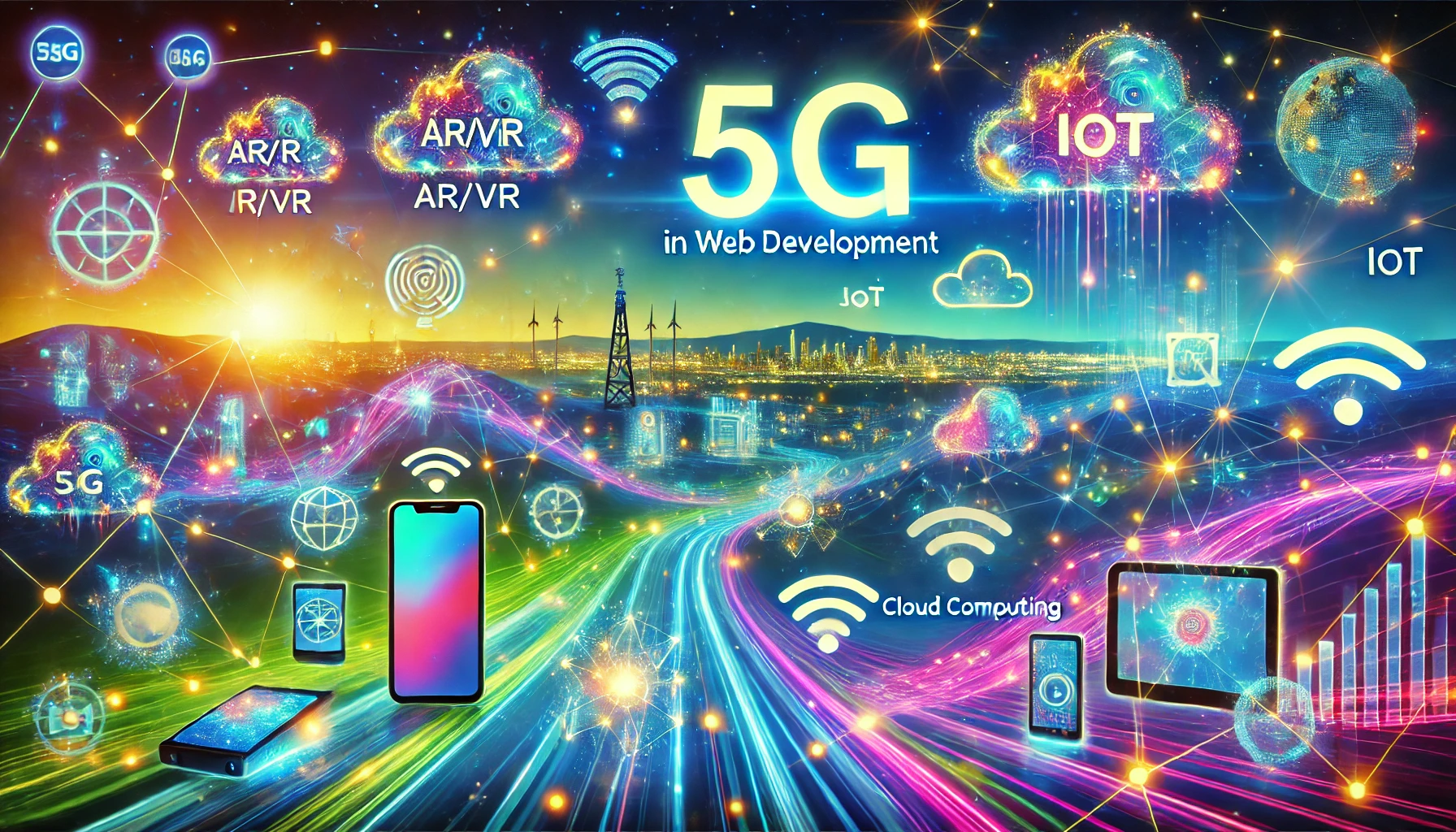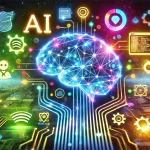Introduction: The Impact of 5G on Digital Technology
The arrival of 5G technology marks a revolutionary shift in telecommunications, bringing unprecedented speed, lower latency, and a more reliable network to the global stage. While 4G dramatically improved mobile connectivity, 5G promises to go beyond faster internet browsing or better streaming quality. It offers a fundamental transformation of how we connect, communicate, and build digital experiences.
One of the key areas that stands to gain immensely from 5G is web development. With the rollout of this technology, developers are now positioned to take advantage of faster data transfer speeds, more seamless connectivity, and greater capacity to create richer, more dynamic web experiences. From enhanced user interfaces to new possibilities in virtual and augmented reality, 5G is poised to redefine how websites are built and experienced by users.
This article will explore in detail the role of 5G in web development, its potential for shaping the future of web technologies, and the new experiences it can enable for end users. We will examine 5G’s impact on speed, user experience, augmented reality (AR) and virtual reality (VR) integration, IoT expansion, real-time data processing, and its contribution to cloud-based development workflows.
1. The Fundamentals of 5G Technology
1.1 What is 5G?
5G, or the fifth generation of mobile networks, is the latest iteration of cellular technology, designed to significantly increase speed, reduce latency, and improve the flexibility of wireless services. Compared to its predecessor, 4G, 5G offers peak data speeds of up to 10 Gbps—roughly 100 times faster than 4G. Moreover, 5G boasts ultra-low latency, potentially reducing delays to less than 1 millisecond, and offers a much higher device capacity, allowing more devices to connect simultaneously without network congestion.
The three key pillars of 5G are:
- Enhanced Mobile Broadband (eMBB): Enables faster internet speeds, making high-quality streaming, downloads, and cloud applications quicker and more seamless.
- Massive Machine-Type Communication (mMTC): Expands the capacity for Internet of Things (IoT) devices, facilitating billions of sensors, devices, and machines to connect without affecting network performance.
- Ultra-Reliable Low Latency Communication (URLLC): Ensures highly responsive and near-instantaneous communication, which is critical for time-sensitive applications like self-driving cars, remote surgeries, and industrial automation.
1.2 How 5G Differs from Previous Generations
Each generation of mobile network technology has brought new advancements, but 5G represents more than just an incremental improvement over 4G. While 4G LTE ushered in high-speed internet, 5G is designed to serve as the backbone for an interconnected digital society. Key differences include:
- Speed and Bandwidth: 5G offers significantly faster download and upload speeds, with greater bandwidth to support more devices.
- Latency: 5G’s ultra-low latency means it can support real-time applications, such as AR/VR and interactive gaming, with almost no noticeable delay.
- Capacity: 5G networks can support up to 1 million devices per square kilometer, compared to 4G’s capacity of around 100,000 devices. This allows for the proliferation of IoT devices and smart city infrastructure.
2. The Role of 5G in Web Development
2.1 Faster Connections: Enhancing User Experience
One of the most obvious benefits of 5G for web development is the dramatic improvement in connection speed. Websites, apps, and online services that rely on data-heavy content—such as high-definition videos, images, or interactive elements—can now load almost instantaneously.
Impact on Loading Times
With 5G, the long-standing issue of slow website loading times, particularly for mobile users, will be significantly alleviated. Websites can now be built with more complex visual elements without worrying about performance bottlenecks or bandwidth constraints. Speed directly impacts user satisfaction, and faster loading times will lead to higher engagement and conversion rates, as studies show users are more likely to abandon a website if it takes more than 3 seconds to load.
Improved Mobile Browsing
The mobile-first design approach will become even more critical with 5G. Mobile web experiences will benefit tremendously from faster connections, especially in regions where mobile internet is the primary means of web access. 5G will allow mobile users to experience desktop-like speeds, empowering developers to create richer, more engaging mobile websites without sacrificing performance.
Performance of Web Applications
Web applications, particularly Progressive Web Apps (PWAs), will thrive in a 5G environment. PWAs are designed to work on any device with a single codebase and offer offline functionality, but their full potential has been somewhat constrained by the limitations of 4G. With 5G, PWAs can now deliver near-native app experiences with faster responses and enhanced functionality, making them a compelling alternative to traditional apps.
2.2 Smarter Experiences: AR, VR, and Immersive Web Technologies
5G unlocks new possibilities for integrating advanced technologies like augmented reality (AR) and virtual reality (VR) into web development, offering smarter, more immersive user experiences.
AR and VR Integration in Web Design
AR and VR require significant bandwidth and ultra-low latency to work effectively. 5G’s capabilities make it possible to integrate AR/VR experiences directly into websites without needing specialized hardware or app downloads. For example, e-commerce websites can use AR to allow customers to virtually “try on” products like clothing or makeup, or to visualize how furniture would look in their homes. VR can offer immersive tours of real estate properties or interactive 3D product demos.
The 5G network allows these resource-intensive applications to load quickly and operate smoothly, reducing barriers for users and improving the overall web experience.
WebXR and 3D Content
WebXR, a JavaScript API for creating immersive 3D content, stands to benefit immensely from 5G. Currently, WebXR is limited by network speeds, but with 5G’s high throughput, developers can create more complex and interactive 3D environments. These environments can be used in everything from virtual shopping experiences to interactive educational tools, making the web a more interactive and engaging space.
Real-Time Collaboration and Interaction
The low latency of 5G networks will also facilitate real-time collaboration and interaction within web applications. For example, multiplayer gaming platforms, virtual workspaces, and collaborative design tools that rely on real-time interaction can now perform more efficiently and provide seamless, lag-free experiences.
3. How 5G is Transforming Web Technologies
3.1 The Internet of Things (IoT) and Web Development
The explosion of IoT devices made possible by 5G is set to have a profound impact on web development. With 5G’s increased capacity and ability to support a vast number of connected devices, web developers will need to design for a world where everything from household appliances to vehicles is connected to the internet.
IoT-Driven Websites
Websites that cater to IoT ecosystems will need to prioritize seamless data integration, real-time updates, and high levels of customization. For example, smart home applications require web platforms that can manage multiple devices, offer real-time data on their status, and allow users to control these devices from any location.
Device Interoperability
Web developers will also need to ensure that websites can interact smoothly with a wide variety of IoT devices. This will require building websites that can handle diverse data streams, support multiple communication protocols, and offer consistent user experiences across devices.
Increased Demand for Real-Time Data Processing
The increased number of connected devices will generate enormous amounts of data, much of which will need to be processed in real-time. Web developers will need to focus on building websites that can handle this influx of data while ensuring smooth user experiences. Technologies such as Edge Computing will play a critical role in enabling this, as they allow data to be processed closer to the source (i.e., the IoT devices themselves) rather than in distant data centers, reducing latency and improving performance.
3.2 Real-Time Data and Edge Computing
5G’s ability to support real-time data processing will also open the door to more interactive, data-driven web experiences.
Edge Computing and Web Performance
As the number of connected devices increases, the traditional model of centralized cloud computing may no longer be sufficient to handle the load. Edge Computing, where data is processed at the “edge” of the network (closer to the user), will be crucial in enabling the real-time processing that many 5G-enabled applications require.
For web developers, this means rethinking how data is handled and processed. Instead of relying solely on centralized servers, developers will need to consider how to incorporate edge computing into their architectures. This will allow for faster, more efficient web applications that can handle the demands of real-time data processing.
Real-Time Analytics
The ability to process data in real-time will also allow for more personalized and dynamic web experiences. Websites will be able to offer users real-time insights, personalized content recommendations, and dynamic updates based on their behavior and preferences. For example, e-commerce platforms could use real-time data to offer personalized product recommendations based on a user’s browsing and purchase history, while news websites could deliver breaking news updates as they happen.
4. 5G’s Impact on Web Development Workflow
4.1 Cloud-Based Development and Remote Workflows
As 5G becomes more widespread, web developers will benefit from the increased flexibility and scalability offered by cloud-based development workflows.
Faster Cloud Access
5G’s faster speeds will make it easier for developers to access cloud-based development environments, allowing for more efficient collaboration and streamlined workflows. This will be especially beneficial for remote teams, who can now work together in real-time without being hindered by slow connections or lag.
Serverless Architecture
The rise of serverless computing, where developers build applications without managing the underlying server infrastructure, will also be accelerated by 5G. With 5G’s high-speed connectivity, developers can build more scalable and responsive web applications using serverless architectures. This will reduce the need for expensive server maintenance and allow developers to focus on building applications that can handle large volumes of traffic with minimal downtime.
4.2 Collaborative Web Development Platforms
5G’s low latency will also enable more sophisticated collaborative development platforms, allowing teams to work together in real-time, even when spread across different locations. Tools like Visual Studio Live Share and GitHub Codespaces already offer real-time collaboration features, but 5G’s improved connectivity will take this to the next level. Developers will be able to collaborate on code, design, and testing without experiencing any delays, leading to faster development cycles and more efficient workflows.
5. Overcoming Challenges in 5G-Driven Web Development
While 5G brings immense potential, it also presents new challenges for web developers. These include the need to manage greater network complexity, ensure compatibility with older devices and networks, and address privacy and security concerns.
5.1 Managing Network Complexity
As 5G networks become more widespread, web developers will need to manage the complexity of designing for a variety of network environments. While 5G offers faster speeds and lower latency, it may not be available everywhere immediately. Developers will need to ensure that websites are optimized for both 5G and older networks, providing a consistent user experience across different connection types.
5.2 Ensuring Device Compatibility
With the proliferation of IoT devices, web developers will need to ensure that their websites are compatible with a wide range of devices, from smartphones to smart refrigerators. This will require designing for different screen sizes, communication protocols, and data formats, as well as ensuring that websites can handle the unique demands of each device.
5.3 Addressing Privacy and Security Concerns
As 5G enables more devices to connect to the internet and generates more data, privacy and security concerns will become increasingly important. Web developers will need to prioritize building secure websites that protect user data and prevent unauthorized access. This will require implementing robust encryption protocols, securing APIs, and ensuring that websites comply with data protection regulations like GDPR.
Conclusion: 5G and the Future of Web Development
The advent of 5G represents a significant leap forward for web development, opening up new possibilities for creating faster, smarter, and more immersive web experiences. From enhanced user interfaces to seamless integration with IoT devices, AR, and VR, 5G offers web developers the tools they need to build the next generation of websites and web applications.
However, with these new opportunities come new challenges. Web developers will need to adapt to the complexities of 5G networks, ensure compatibility with a growing number of connected devices, and prioritize security and privacy in their designs.
As 5G continues to roll out globally, its impact on web development will only grow. The future of web development lies in harnessing the full potential of 5G to create faster, smarter, and more personalized digital experiences that meet the needs of an increasingly connected world. By embracing the opportunities offered by 5G, web developers can stay at the forefront of this technological revolution and build the websites of the future.





